A red giant star is a luminous giant star of low or intermediate mass in a late phase of stellar evolution. Its outer atmosphere is inflated and tenuous making its radius several times larger than that of our Sun, and the surface temperature is usually around 5,000 K.
Key Facts & Summary
- A red giant star’s appearance is usually from yellow-orange to red, including the spectral types K and M, but also S class stars and carbon stars.
- A red giant star is a dying star in the last stages of its stellar evolution.
- Red giant stars usually result from low and intermediate-mass main-sequence stars of around 0.5 to 5 solar masses.
- Red giant stars differ in a way by which they generate energy.
- Most of the well-known bright stars are red giants, due to their luminosity and because they are moderately common.
- Red giant stars no longer perform nuclear fusion between helium and hydrogen in their cores and thus they heat up and expand several times their previous size.
- All stars die when they burn up all their fuel and there is no more pressure to keep gravity pushing towards their centers.
- Red giant stars are between 100 to 1.000 times more luminous than our Sun.
- Most red giant stars live up to around 0.1 to 2 billion years.
- Red giant stars are much smaller and much less massive than red supergiant stars.
- Some famous red giant stars are Aldebaran and Arcturus.
- Our own star, the Sun, will eventually become a red giant star and expand several times its current diameter.
- One of the biggest red giants ever discovered is VY Canis Majoris, being around 1,400 times bigger than our Sun.
- Some red giants have planets orbiting around them. It is theorized that red giants can have a stable habitable zone, allowing life to probably develop on planets.
- The Earth will eventually be consumed by a red giant, our Sun.
Formation
The majority of stars in the universe are main-sequence stars – they are stars that still convert hydrogen into helium through nuclear fusion. Main-sequence stars have a mass between a third to eight times that of the Sun, and they eventually burn through their hydrogen supplies.
A red giant star is formed when a star, like our Sun, burns all of its hydrogen and helium supplies. This process can take up to 10 billion years.
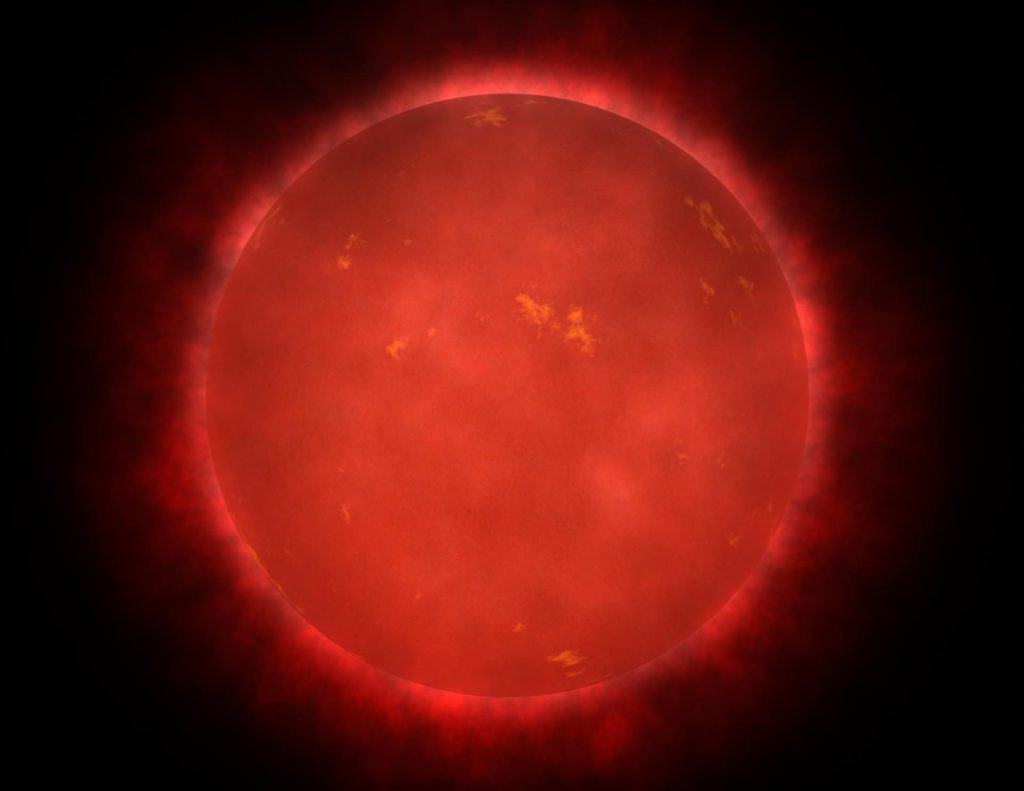
When a star becomes a red giant, it will start to expand and become denser. It will then start burning helium to carbon for a couple of million of years until, eventually, the helium runs out.
When helium runs out, the star will not be dense enough to form other heavy elements like iron, thus the fusion process will stop, and the star will collapse on its core due to inward acting gravity.
This happens because there is no longer any fusion energy to stabilize gravity. Red giant may eventually become white dwarfs, a cool and extremely dense star, with its size being shrunk several times, to that of a planet even.
Characteristics
A red giant star reaches sizes of about 100 million to 1 billion kilometers / 62 million to 621 million miles in diameter, or 100 to 1,000 times the size of our Sun.
Since a red giant star’s energy spreads across a larger area, its surface temperatures are cooler, reaching only 2,200 to 3,200 degrees Celsius / 4,000 to 5,800 degrees Fahrenheit, a little over half as hot as our Sun.
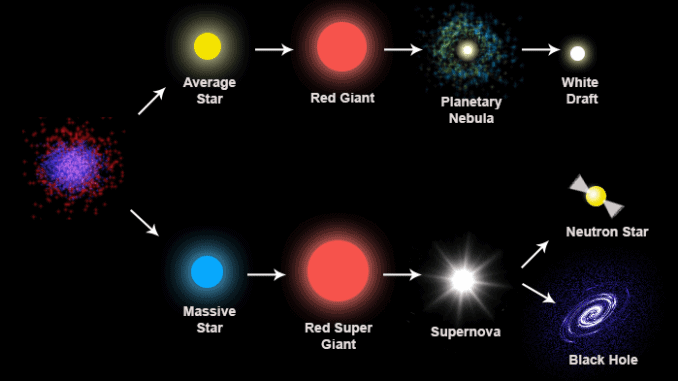
Because of this change in temperature, the star begins to shine in the redder part of the spectrum, leading to the name red giant, though they are often more orange in appearance.
Red giants stars remain in this stage from a few thousand to 1 billion years. They eventually run out of helium in their cores and thus fusion stops.
This causes the star to shrink until a new helium shell reaches its core. When the helium ignites, the outer layers of the star are blown off in huge clouds of gas and dust known as planetary nebulae. These shells are much larger and fainter than their parent stars.
Evolution
Red giants evolve out of main-sequence stars that have masses in the range from around 0.3 solar masses to around 8 solar masses. Stars initially form from collapsing molecular clouds in the interstellar medium.
These clouds contain hydrogen and helium, with trace amounts of metals, and all of these elements are uniformly mixed throughout the star.
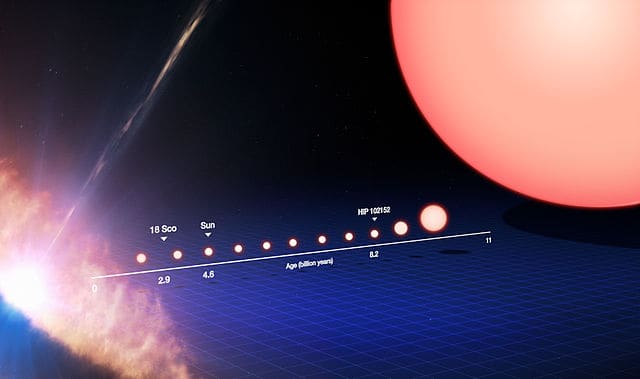
The star reaches the main sequence when the core reaches a temperature high enough to begin fusing hydrogen and establishes hydrostatic equilibrium.
Over a star’s main sequence life, it slowly converts hydrogen in the core to helium. A star’s main sequence life ends when nearly all its hydrogen supplies in the core have been fused.
When the hydrogen supplies are exhausted, nuclear reactions can no longer continue and thus the core begins to contract due to its own gravity.
This brings additional hydrogen into a zone where the temperature and pressure are sufficient to cause fusion to resume in a shell around the core.
The hydrogen-burning shell results in a situation that has been described as the mirror principle, when the core within the shell contracts, the layers of the star outside the shell must expand.
The evolutionary path the star takes as it moves along the red-giant phase depends solely on its mass. For example, the Sun and stars of less than 2 solar masses, the core will become dense enough that electron degeneracy pressure will prevent it from collapsing further.
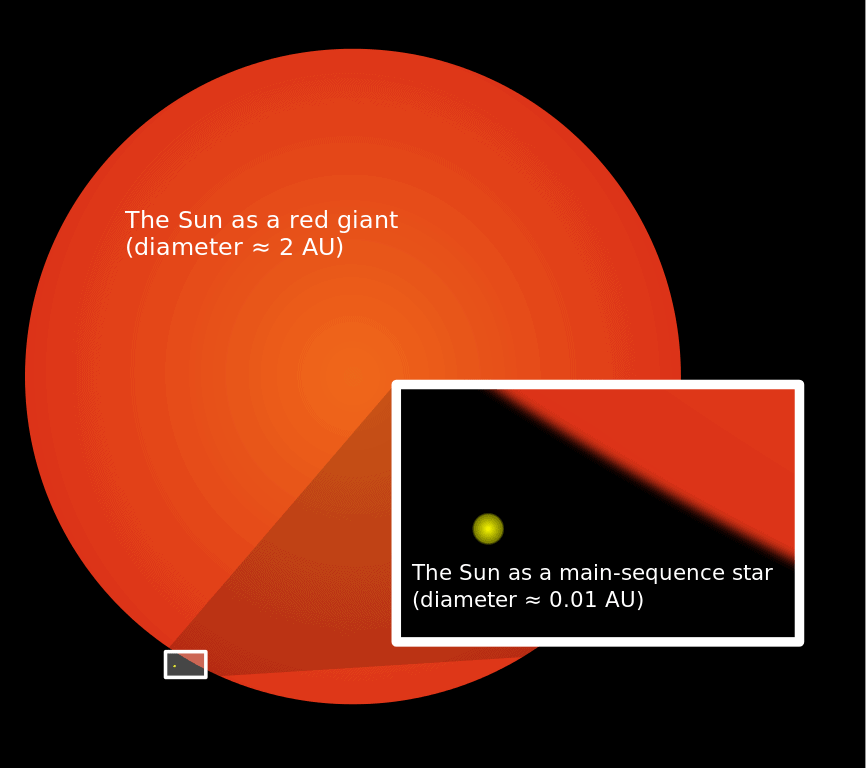
Once the core is degenerate, it will continue to heat until it reaches a temperature of roughly 108 K, hot enough to begin fusing helium to carbon via the triple-alpha process.
When the degenerate core reaches this temperature, the entire core will begin helium fusion nearly simultaneously in a so-called helium flash.
More massive stars will have their collapsing cores reach 108 K before it is dense enough to be degenerate, thus helium fusion will begin much more smoothly and won’t produce a helium flash.
An analogous process occurs when the central helium is exhausted and the star collapses once again, causing helium in a shell to begin fusing.
At the same time, hydrogen may begin fusion in a shell just outside the burning helium shell, which puts the star onto the asymptotic giant branch, a second red-giant phase.
A star that has fewer than 8 solar masses will never start fusion in its degenerate core. However, at the end of its second phase, the star will eject its outer layers, forming a planetary nebula, and having its core exposed, ultimately becoming a white dwarf.
Location
Red giant stars are spread across the universe. Some of them are very close to us while others are unfathomably far away. But let us take a look at some famous red giant stars.
Aldebaran is a red giant star situated at around 65 light-years away from us. It is the brightest star in the zodiacal constellation of Taurus, the celestial bull.
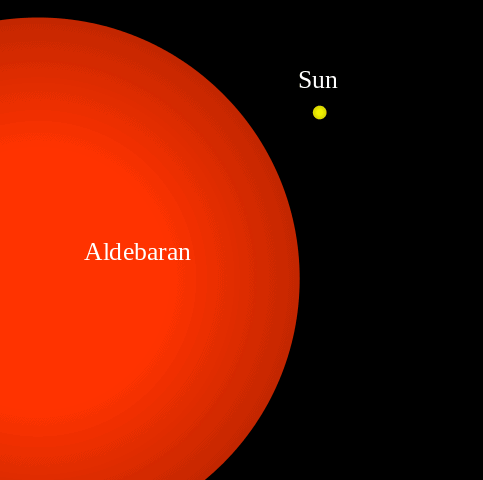
It varies slightly in brightness between magnitudes 0.75 and 0.95 – however, this cannot be observed with the naked eye.
Arcturus is a red giant star located at around 36.7 light-years away from the Sun. It is the brightest star in the constellation of Boötes. It is also the fourth brightest star in the night sky, yet the brightest in the northern hemisphere.
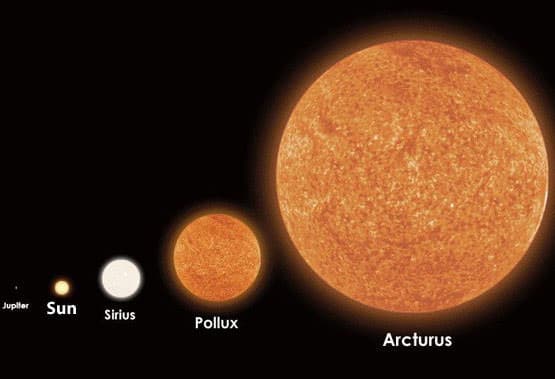
Another example of a red giant is Gacrux. It is the third brightest star in the Southern Cross asterism. All of its star neighbors are blue, thus Gacrux stands out with its reddish color. It is situated at 88.6 light-years away from us.
The Future
Red giant stars live for many years, and we don’t have to worry about them. However, in approximately 5 billion years from now, a red giant will emerge quite close to us.
Our Sun will actually become a red giant star. When this will happen, the Sun will expand its outer layers and consume Mercury, Venus, and eventually Earth.
Did you know?
- When the Sun will become a red giant, its radius will increase to nearly 100 times its present size, and its temperatures will drop as low as 3,000 K.
- In a red giant, a huge, cool, and low-density hydrogen envelope encloses a small, hot, high-density helium core – with a density of about 1,000 tons / m3.
- Red giants are several times more luminous than our Sun due to their great size.
- Some red giants can become so large, that if we were to replace our Sun with one of them, they could reach the orbit of Mars, and even beyond.
Sources:
Image sources:
- https://www.universetoday.com/wp-content/uploads/2015/01/3_RedNASA.jpg
- https://www.astronomytrek.com/wp-content/uploads/2017/07/tmp841796500534067201.png
- https://upload.wikimedia.org/wikipedia/commons/thumb/6/6f/The_life_cycle_of_a_Sun-like_star_%28annotated%29.jpg/640px-The_life_cycle_of_a_Sun-like_star_%28annotated%29.jpg
- https://upload.wikimedia.org/wikipedia/commons/thumb/7/7c/Sun_red_giant.svg/866px-Sun_red_giant.svg.png
- https://upload.wikimedia.org/wikipedia/commons/thumb/4/45/Aldebaran-Sun_comparison-en.svg/1200px-Aldebaran-Sun_comparison-en.svg.png
- https://i2.wp.com/astrobob.areavoices.com/files/2016/04/arcturus-size-comp_edited-1-1.jpg?fit=640%2C438
